- Home
- Ursula K. Le Guin
A Fisherman of the Inland Sea: Stories Page 6
A Fisherman of the Inland Sea: Stories Read online
Page 6
2/23. Making ready. Tightened gossels. Weather holds.
2/24. Reached Verandah Camp easily in one day’s climb. Tricky bit where the lattice and tongue and groove join, but Advance Party had left rope in place and we negotiated the overhang without real difficulty. Omu Ba used running jump and arrived earlier than rest of party. Inventive but undisciplined. Bad example to other Sherbets. Verandah Camp is level, dry, sheltered, far more comfortable than Base. Glad to be out of the endless rhododendrons. Snowing tonight.
2/25. Immobilized by snow.
2/26. Same.
2/27. Same. Finished last sheets of Times (adverts).
2/28. Derek, Nigel, Colin, and I went up in blinding snow and wind to plot course and drive pigils. Visibility very poor. Nigel whined.
Turned back at noon, reached Verandah Camp at 3 pip emma.
2/29. Driving rain and wind. Omu Ba drunk since 2/27. What on? Stove alcohol found to be low. Inventive but undisciplined. Chastisement difficult in circumstances.
2/30. Robert roped right up to the North-East Overhang. Forced to turn back by Sherbets’ dread of occupants. Insuperable superstition. We must eliminate plans for that route and go straight for the Drain Pipe. We cannot endure much longer here crowded up in this camp without newspapers. There is not room for six men in our tent, and we hear the sixteen Sherbets fighting continually in theirs. I see now that the group is unnecessarily numerous even if some are under 5 foot 2 inches in height. Ten men, handpicked, would be enough. Visibility zero all day. Snow, rain, wind.
2/31. Hail, sleet, fog. Three Sherbets have gone missing.
3/1. Out of Bovril. Derek very low.
3/4. Missed entries during blizzard. Today bright sun, no wind. Snow dazzling on lower elevations; from here we cannot see the heights. Sherbets returned from unexplained absence with Ovaltine. Spirits high. Digging out and making ready all day for ascent (two groups) tomorrow.
3/5. Success! We are on the Verandah Roof! View overwhelming. Unattained summit of 2618 clearly visible in the SE. Second Party (Peter, Robert, eight Sherbets) not here yet. Windy and exposed campsite on steep slope. Shingles slippery with rain and sleet.
3/6. Nigel and two Sherbets went back down to the North Edge to meet Second Party. Returned 4 pip emma without having sighted them. They must have been delayed at Verandah Camp. Anxiety. Radio silent. Wind rising.
3/7. Colin strained shoulder on rope climbing up to the Window. Stupid, childish prank. Whether or not there are occupants, the Sherbets are very strong on not disturbing them. No sign of Second Party. Radio messages enigmatic, constant interference from KWJJ Country Music Station. Windy, but clear weather holds.
3/8. Resolved to go up tomorrow if weather holds. Mended doggles, replaced worn pigil-holders. Sherbets noncommittal.
3/9. I am alone on the High Roof.
No one else willing to continue ascent. Colin and Nigel will wait for me three days at Verandah Roof Camp; Derek and four Sherbets began descent to Base. I set off with two Sherbets at 5 ack emma. Fine sunrise, in East, at 7.04 ack emma. Climbed steadily all day. Tricky bit at last overhang. Sherbets very plucky. Omu Ba while swinging on rope said, “Observe fine view, sah!” Exhausted at arrival at High Roof Camp, but the three advance Sherbets had tents set up and Ovaltine ready. Slope so steep here I feel I may roll off in my sleep!
Sherbets singing in their tent.
Above me the sharp Summit, and the Chimney rising sheer against the stars.
That is the last entry in Simon Interthwaite’s journal. Four of the five Sherbets with him at the High Roof Camp returned after three days to the Base Camp. They brought the journal, two clean vests, and a tube of anchovy paste back with them. Their report of his fate was incoherent. The Interthwaite Party abandoned the attempt to scale the North Face of 2647 Lovejoy Street and returned to Calcutta.
In 1980 a Japanese party of Izutsu employees with four Sherbet guides attained the summit by a North Face route, rappelling across the study windows and driving pitons clear up to the eaves. Occupant protest was ineffective.
No one has yet climbed the Chimney.
THE ROCK THAT CHANGED THINGS
A nurobl called Bu, working one day with her crew on the rockpile of Obling College, found the rock that changed things.
Where the obls live, the shores of the river are rocky. Boulders, large stones, small stones, pebbles, and gravel lie piled and scattered for miles up and down the banks. The towns of the obis are built of stone; they hunt the rock-coney for their meat feasts. Their nurobls gather and prepare stonecrop and lichen for ordinary food, and build the houses and the colleges, and keep them neat, for the obis grow nervous and unhappy when things are not kept in order.
The heart of an obl town is its college, and the pride of every college is its terraces, which shelve down towards the river from the high stone buildings. The stones of the terraces are arranged according to size: boulders make the outer walls, and within them are rows of large rocks, then banks of small stones, and at last the inner terraces of pebbles set in elaborate mosaics and patterns in gravel. On the terraces the obis stroll and sit in the long, warm days, smoking ta-leaf in pipes of soapstone, and discussing history, natural history, philosophy, and metaphysics. So long as the rocks are arranged in order of shape and size and the patterns are kept clear and tidy, the obls have peace of mind and can think deeply. After their conversations on the terraces, the wisest old obls enter the colleges and write down the best of what was thought and said, in the Books of Record that are kept neatly ranged on the shelves of the college libraries.
When the river floods in early spring and rises up the terraces, tumbling the rocks about, washing the gravel away, and causing great disorder, the obls stay inside the colleges. There they read the Books of Record, discuss and annotate, plan new designs for the terraces, eat meat feasts, and smoke. Their nurs cook and serve the feasts and keep the rooms of the colleges orderly. As soon as the floods pass, the nurs begin to sort the rocks and straighten up the terraces. They hurry to do so because the disorder left by the floods makes the obis very nervous, and when they are nervous they beat and rape the nurs more harshly than usual.
The spring floods this year had broken through the boulder wall of the town of Obling, leaving branches and driftwood and other litter on the terraces and disturbing or destroying many of the patterns. The terraces of Obling College are notable for the perfect order and complex beauty of their pebble-patterns. Famous obis have spent years of their lives designing the patterns and choosing the stones; one great designer, Aknegni, is said to have worked with his own hands to perfect his creation. If a single pebble is lost from such a design, the nurobls will spend days hunting through the rockpiles for a replacement of precisely the right shape and size. On such a task the nurobl called Bu was engaged, along with her crew, when she came upon the stone that changed things.
When replacement rocks are needed, the rockpile nurs often make a rough copy of that section of the terrace mosaic, so that they can test pebbles in it for fit without carrying them all the way up to the inner terraces. Bu had placed a trial stone in a test pattern in this fashion, and was gazing at it to be sure the size and shape were exact, when she was struck by a quality of the stone which she had never noticed before: the color. The pebbles of this part of the design were all large ovals, a palm-and-a-quarter wide and a palm-and-a-half long. The rock Bu had just set into the test pattern was a perfect “quarter-half” oval, and so fit exactly; but while the other rocks were mostly a dark, smooth-grained bluish grey, the new one was a vivid blue-green, with flecks of paler jade green.
Bu knew, of course, that the color of a rock is a matter of absolute indifference, an accidental and trivial quality that does not affect the true pattern in any way. All the same, she found herself gazing with peculiar satisfaction at this blue-green stone. Presently she thought, “This stone is beautiful.” She was not looking, as she should have been, at the whole design, but at the one stone, whose color was set off
by the duller hue of the others. She was strangely moved; strange thoughts arose in her mind. She thought, “This stone is significant. It means. It is a word.” She picked it up and held it while studying the test pattern.
The original design, up on the terrace, was called the Dean’s Design, for the Dean of the College, Festl, who had planned this section of the terraces. When Bu replaced the blue-green stone in the pattern, it still caught her eye by its color, distracting her mind from the pattern, but she could not see any meaning in it.
She took the blue-green stone to the rockpile fore-nur and asked him if he saw anything wrong, or odd, or particular about the stone. The fore-nur gazed thoughtfully at the stone, but at last opened his eyes wide, meaning no.
Bu took the stone up to the inner terraces and set it into the true pattern. It fitted the Dean’s Design exactly; its shape and size were perfect. But, standing back to study the pattern, Bu thought it scarcely seemed to be the Dean’s Design at all. It was not that the new stone changed the design; it simply completed a pattern that Bu had never realized was there: a pattern of color, that had little or no relation to the shape-and-size arrangement of the Dean’s Design. The new stone completed a spiral of blue-green stones within the field of interlocked rhomboids of “quarter-half” ovals that formed the center of Festl’s design. Most of the blue-green stones were ones that Bu had laid over the past several years; but the spiral had been begun by some other nur, before Bu was promoted to the Dean’s Design.
Just then Dean Festl came strolling out in the spring sunshine, his rusty gun on his shoulder, his pipe in his mouth, happy to see the disorder of the floods being repaired. The Dean was a kind old obl who had never raped Bu, though he often patted her. Bu summoned up her courage, hid her eyes, and said, “Lord Dean, sir! Would the Lord Dean in his knowledge be so good as to tell me the verbal significance of this section of the true pattern which I have just repaired?”
Dean Festl paused, perhaps a touch displeased to be interrupted in his meditations; but seeing the young nur so modestly crouching and hiding all her eyes, he patted her in a forebearing way and said, “Certainly. This subsection of my design may be read, on the simplest level, as: ‘I place stones beautifully,’ or ‘I place stones in excellent order.’ There is an immanent higher-plane postverbal significance, of course, as well as the Ineffable Arcana. But you needn’t bother your little head with that!”
“Is it possible,” the nur asked in a submissive voice, “to find a meaning in the colors of the stones?”
The Dean smiled again and patted her in several places. “Who knows what goes on in the heads of nurs! Color! Meaning in color! Now run along, little nurblit. You’ve done very pretty repair work here. Very neat, very nice.” And he strolled on, puffing on his pipe and enjoying the spring sunshine.
Bu returned to the rockpile to sort stones, but her mind was disturbed. All night she dreamed of the blue-green rock. In the dream the rock spoke, and the rocks about it in the pattern began speaking too. Waking, Bu could not remember the words the stones had said.
The sun was not up yet, but the nurs were; and Bu spoke to several of her nestmates and work-friends while they fed and cleaned the blits and ate their hurried breakfast of cold fried lichen. “Come up onto the terraces, now, before the obls are up,” Bu said. “I want to show you something.”
Bu had many friends, and eight or nine nurs followed her up onto the terraces, some of them bringing their nursing or toddling blits along. “What’s Bu got in her head this time!” they said to each other, laughing.
“Now look,” Bu said when they were all on the part of the inner terrace that Dean Festl had designed. “Look at the patterns. And look at the colors of the rocks.”
“Colors don’t mean anything,” said one nur, and another, “Colors aren’t part of the patterns, Bu.”
“But what if they were?” said Bu. “Just look.”
The nurs, being used to silence and obedience, looked.
“Well,” said one of them after a while. “Isn’t that amazing!”
“Look at that!” said Bu’s best friend, Ko. “That spiral of blue-green running all over the Dean’s Design! And there’s five red hematites around a yellow sandstone—like a flower.”
“This whole section in brown basalt—it cuts across the—the real pattern, doesn’t it?” said little Ga.
“It makes another pattern. A different pattern,” Bu said. “Maybe it makes an immanent pattern of ineffable significance.”
“Oh, come off it, Bu,” said Ko. “You a Professor or something?”
The others laughed, but Bu was too excited to see that she was funny. “No,” she said earnestly, “but look—that blue-green rock, there, the last one in the spiral.”
“Serpentinite,” said Ko.
“Yes, I know. But if the Dean’s Design means something—He said that that part means ‘I place stones beautifully’—Well, could the blue-green rock be a different word? With a different meaning?”
“What meaning?”
“I don’t know. I thought you might know.” Bu looked hopefully at Un, an elderly nur who, though he had been lamed in a rockslide in his youth, was so good at fine pattern-maintenance that the obls had let him live. Un stared at the blue-green stone, and at the curve of blue-green stones, and at last said slowly, “It might say, “The nur places stones.’”
“What nur?” Ko asked.
“Bu,” little Ga said. “She did place the stone.”
Bu and Un both opened their eyes wide, to signify No.
“Patterns aren’t ever about nurs!” said Ko.
“Maybe patterns made of colors are,” said Bu, getting excited and blinking very fast.
“The nur,’” said Ko, following the blue-green curve with all three eyes, “—’the nur places stones beautifully in uncontrollable loopingness.’ My goodness! What’s that all about?” He read on along the curve—” ‘in uncontrollable loopingness fore,’ what’s that? Oh, ‘foreshadowing the seen.’ ”
“ ‘The vision,’” Un suggested. “‘The vision of … ‘I don’t know the last word.”
“Are you seeing all that in the colors of the rocks?” asked Ga, amazed.
“In the patterns of the colors,” Bu replied. “They aren’t accidental. Not meaningless. All the time, we have been putting them here in patterns—not just ones the obis design and we execute, but other patterns—nur patterns—with new meanings. Look—look at them!”
Since they were used to silence and obedience, they all stood and looked at the patterns on the inner terraces of the College of Obling. They saw how the arrangement by shape and size of the pebbles and larger stones made regular squares, oblongs, triangles, dodecahedrons, zigzags, and rectilinear designs of great and orderly beauty and significance. And they saw how the arrangement of the stones by color had created other designs, less complete, often merely sketched or hinted—circles, spirals, ovals, and complex curvilinear mazes and labyrinths of great and unpredictable beauty and significance. So a long loop of white quartzites cut right across the quarter-palm straight-edge double line; and the rhomboid section of half-palm sandstones seemed to be an element in a long crescent of pale yellow.
Both patterns were there; did one cancel the other, or was each part of the other? It was difficult to see them both at once, but not impossible.
After a long time little Ga asked, “Did we do all that without even knowing we were doing it?”
“I always looked at the colors of the rocks,” Un said in a low voice, looking down.
“So did I,” Ko said. “And the grain and texture, too. I started that wiggly part in the Crystal Angles,” pointing at a very ancient and famous section of the terrace, designed by the great OholothL. “Last year, after the late flood, when we lost so many stones from the design, remember? I got a lot of amethysts from the Ubi Caves. I love purple!” His tone was defiant.
Bu looked at a circle of small, smooth turquoises inlaid in a corner of a set of interlocked re
ctangles. “I like blue-green,” Bu said in a whisper. “I like blue-green. He likes purple. We see the colors of the stones. We make the pattern. We make the pattern beautifully.”
“Should we tell the Professors, do you think?” little Ga asked, getting excited. “They might give us extra food.”
Old Un opened all his eyes very wide. “Don’t breathe a word of this to the Professors! They don’t like patterns to change. You know that. It makes them nervous. They might get nervous and punish us.”
“We are not afraid,” Bu said, in a whisper.
“They wouldn’t understand,” Ko said. “They don’t look at colors. They don’t listen to us. And if they did, they’d know it was just nurs talking and didn’t mean anything. Wouldn’t they? But I’m going back to the Caves and get some more amethysts and finish that wiggly part,” pointing to the Crystal Angles, where repairs had scarcely begun. “They’ll never even see it.”
Ga’s naughty little blit, Professor Endl’s son, was digging up pebbles from the Superior Triangle, and had to be spanked. “Oh,” Ga sighed, “he’s all oblblit! I just don’t know what to do with him.”
“He’ll go to School next year,” Un said drily. “They’ll know what to do with him.”
“But what will I do without him?” said Ga.
The sun was well up in the sky now, and Professors could be seen looking out from their bedroom windows over the terraces. They would not like to see nurs loitering, and small blits were, of course, absolutely forbidden within the college walls. Bu and the others hastily returned to the nests and workhouses.
Ko went to the Ubi Caves that same day, and Bu went along; they came back with sacks of fine amethysts, and worked for several days completing the wiggly part, which they called the Purple Waves, in the repair and maintenance of the Crystal Angles. Ko was happy in the work, and sang and joked, and at night he and Bu made love. But Bu remained preoccupied. She kept studying the patterns of color on the terraces, and finding more and more of them, and more and more meanings and ideas in them.

 Catwings
Catwings Tehanu
Tehanu The Tombs of Atuan
The Tombs of Atuan A Wizard of Earthsea
A Wizard of Earthsea The Other Wind
The Other Wind Ursula K. Le Guin
Ursula K. Le Guin Dangerous People
Dangerous People Worlds of Exile and Illusion: Rocannon's World, Planet of Exile, City of Illusions
Worlds of Exile and Illusion: Rocannon's World, Planet of Exile, City of Illusions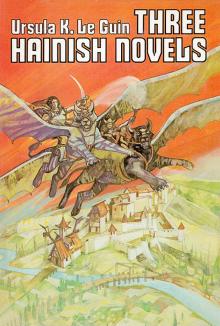 Three Hainish Novels
Three Hainish Novels The Left Hand Of Darkness (SF Masterworks)
The Left Hand Of Darkness (SF Masterworks) The Unreal and the Real - Vol 1 - Where On Earth
The Unreal and the Real - Vol 1 - Where On Earth The Visionary
The Visionary The Ones Who Walk Away from Omelas
The Ones Who Walk Away from Omelas The Word for World is Forest
The Word for World is Forest Always Coming Home
Always Coming Home The Unreal and the Real - Vol 2 - Outer Space, Inner Lands
The Unreal and the Real - Vol 2 - Outer Space, Inner Lands Malafrena
Malafrena The Lathe of Heaven
The Lathe of Heaven Five Ways to Forgiveness
Five Ways to Forgiveness The Eye of the Heron
The Eye of the Heron Four Ways to Forgiveness
Four Ways to Forgiveness Powers
Powers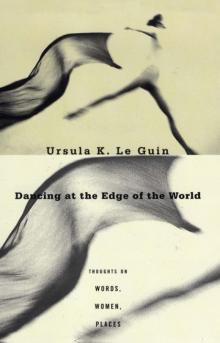 Dancing at the Edge of the World
Dancing at the Edge of the World Very Far Away from Anywhere Else
Very Far Away from Anywhere Else Voices aotws-2
Voices aotws-2 The New Atlantis
The New Atlantis The Unreal and the Real, Selected Stories of Ursula K. Le Guin Volume 1: Where on Earth
The Unreal and the Real, Selected Stories of Ursula K. Le Guin Volume 1: Where on Earth The Telling
The Telling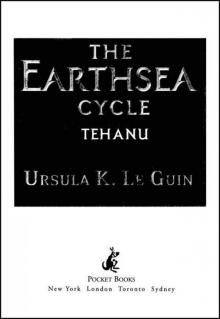 Tehanu (Earthsea Cycle)
Tehanu (Earthsea Cycle) Nine Lives twtq-9
Nine Lives twtq-9 The Birthday of the World and Other Stories
The Birthday of the World and Other Stories The Dispossessed
The Dispossessed Changing Planes
Changing Planes Words Are My Matter
Words Are My Matter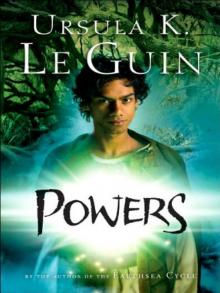 Powers aotws-3
Powers aotws-3 Lavinia
Lavinia The Wind's Twelve Quarters
The Wind's Twelve Quarters Orsinian Tales
Orsinian Tales Gifts aotws-1
Gifts aotws-1 Coming of Age in Karhide
Coming of Age in Karhide The Books of Earthsea: The Complete Illustrated Edition
The Books of Earthsea: The Complete Illustrated Edition The Found and the Lost
The Found and the Lost No Time to Spare
No Time to Spare Voices
Voices The Wild Girls
The Wild Girls Old Music and the Slave Women
Old Music and the Slave Women The Daughter of Odren
The Daughter of Odren A Fisherman of the Inland Sea: Stories
A Fisherman of the Inland Sea: Stories A Wizard of Earthsea (The Earthsea Cycle)
A Wizard of Earthsea (The Earthsea Cycle)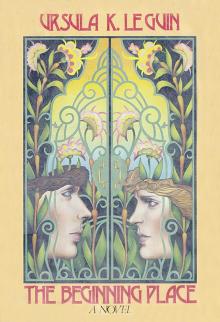 The Beginning Place
The Beginning Place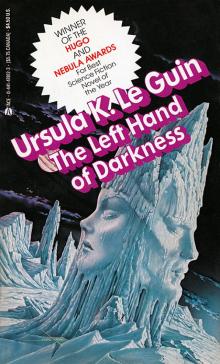 The Left Hand of Darkness
The Left Hand of Darkness The Farthest Shore (Earthsea Cycle)
The Farthest Shore (Earthsea Cycle) The Matter of Seggri botw-2
The Matter of Seggri botw-2